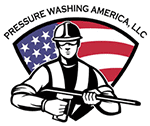If you want to make your residential and commercial property look presentable and clean, pressure washing may be the best and most cost-effective way of achieving this goal. The most significant benefit of pressure and power washing service is removing organic dirt such as mold and mildew.
These types of contaminants not only leave nasty stains on your property’s walls but can also compromise the structural integrity of your home or commercial property.
Why Is Removing Mold Important?
Like we mentioned before, mold, mildew, and algae can damage your property’s wall structure. This happens because mold and mildew actually grow into the wall through the cracks, always chasing after moist areas and carrying a lot of moisture.
If you leave the mold on your walls for too long, it can reach the interior part of the wall, and that’s where it becomes a real problem. Once you notice mold inside your property, it means the wall’s structure has already been damaged. Unfortunately, it also means you and your family, or your employees are now exposed to it.
Mold and mildew are some of the biggest causes of respiratory diseases such as asthma, allergies, and many others. To those people who have asthma, being exposed to mold can often trigger an asthma attack.
Can You Pressure Wash Historic Buildings?
Now, if mold and mildew can cause such problems to newer buildings and homes, can you imagine what it can do to important historic buildings. Because these types of buildings often have a lot of decorations, there are pockets all around the building convenient for mold and mildew growth.
However, we should not approach pressure washing historic buildings as we would to residential property. Historic buildings are built of different materials, and some of them are highly porous. So, in order to successfully pressure wash a historic building, we have to know what we shouldn’t do when it comes to cleaning this type of property.
No Grit!
While some companies offer a sandblasting technique to clean a historic building, this is a big no-no. Any sandblasting or even using wire brushes will prove to be too rough for cleaning old buildings. Such abrasive methods may strip away the paint, scratch the metal and visibly damage the wooden surfaces.
Furthermore, some companies will use grit or particulate within the cleaning solution itself to give a mild sanding effect. This, too, should be avoided.
How To Properly Pressure Wash an Antique Building?
You must remember that old buildings are filled with many types of surfaces and materials that should be treated gently. Marble, bronze, and copper can all change their qualities if harsh cleaning solutions are used, and you can end up destroying what makes your antique home or commercial property unique.
The best way to clean such property is with the ”soft wash” method. A professional soft wash service includes using less than 500 PSI (pound per square inch) for cleaning exterior surfaces. It also includes removing the tip of the pressure washing with another one that will widen the water spray, thus removing one-point pressure.
Moreover, the cleaning solutions combined with the soft wash technique are non-abrasive and environmentally friendly, meaning they will not pollute the environment.
If you are an owner of an old property, historic masonry building, or commercial building, don’t be alarmed when you are advised not to but also to go ahead and pressure wash your property. It all depends on who you ask.
There are a lot of cleaning companies who feel comfortable with cleaning historic buildings with 1,500 psi. On the other hand, cleaning companies who specialize in cleaning masonry buildings complete these types of projects while using 200-800 psi.
However, if you ask an architectural conservator, don’t be surprised if they are uncomfortable with anything above 40 psi, which is what most museum conservators use while cleaning more miniature molded ornaments orbits of the building facade.
This method has its limits because it can’t be used on whole buildings. Such a project would cost much, take a lot of time, not to mention there aren’t many who are competent enough to handle the task.
So, the PSI conundrum is very real, and it relates to the difference in the amount of PSI most cleaning companies and architectural conservators use to clean and preserve antique buildings. Still, a good pressure washing company will be willing to work with the architecture conservator and advise about the best amount of PSI that should be used.




